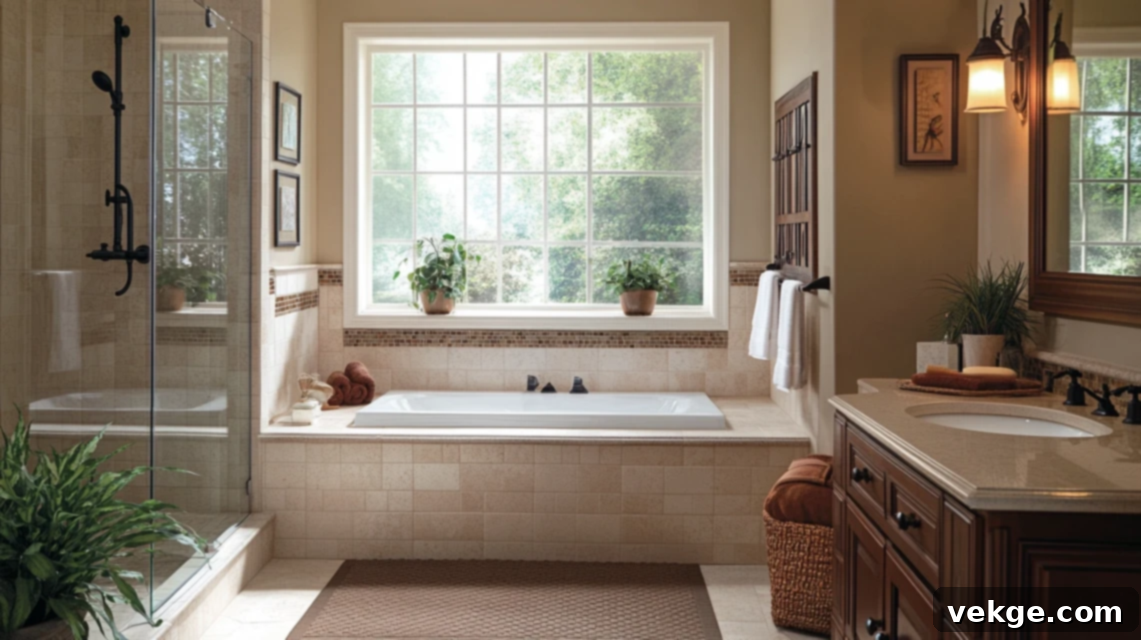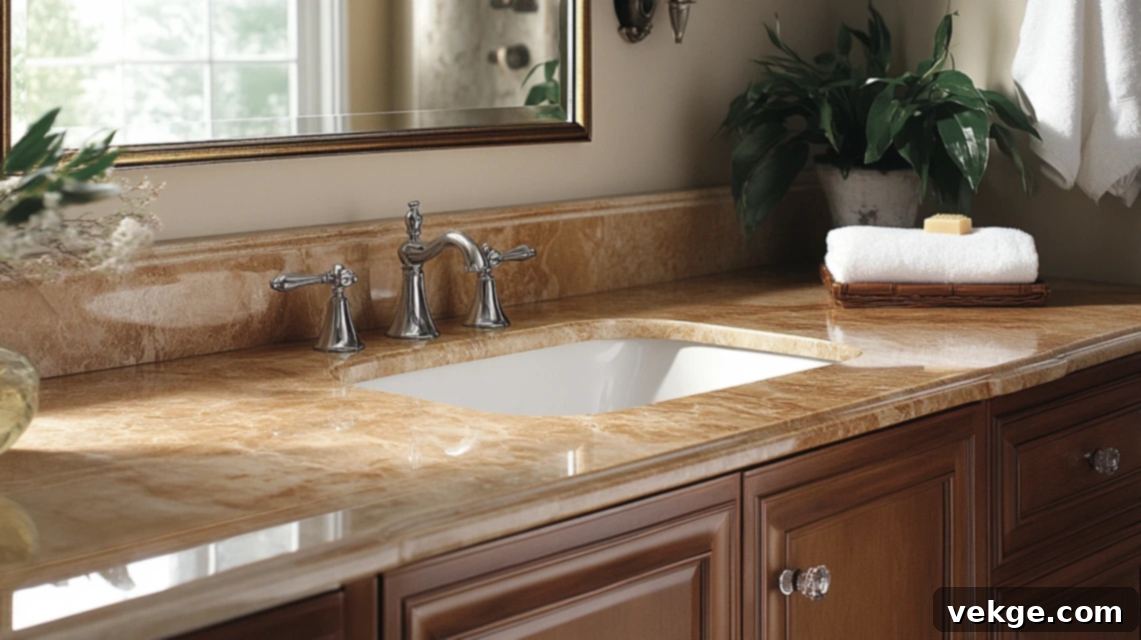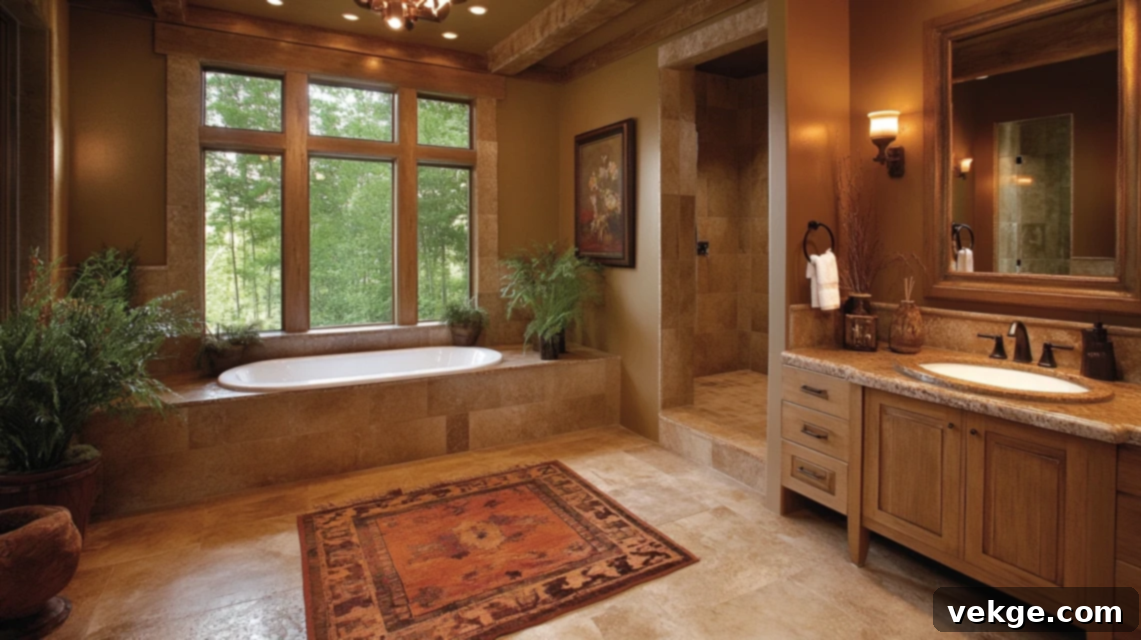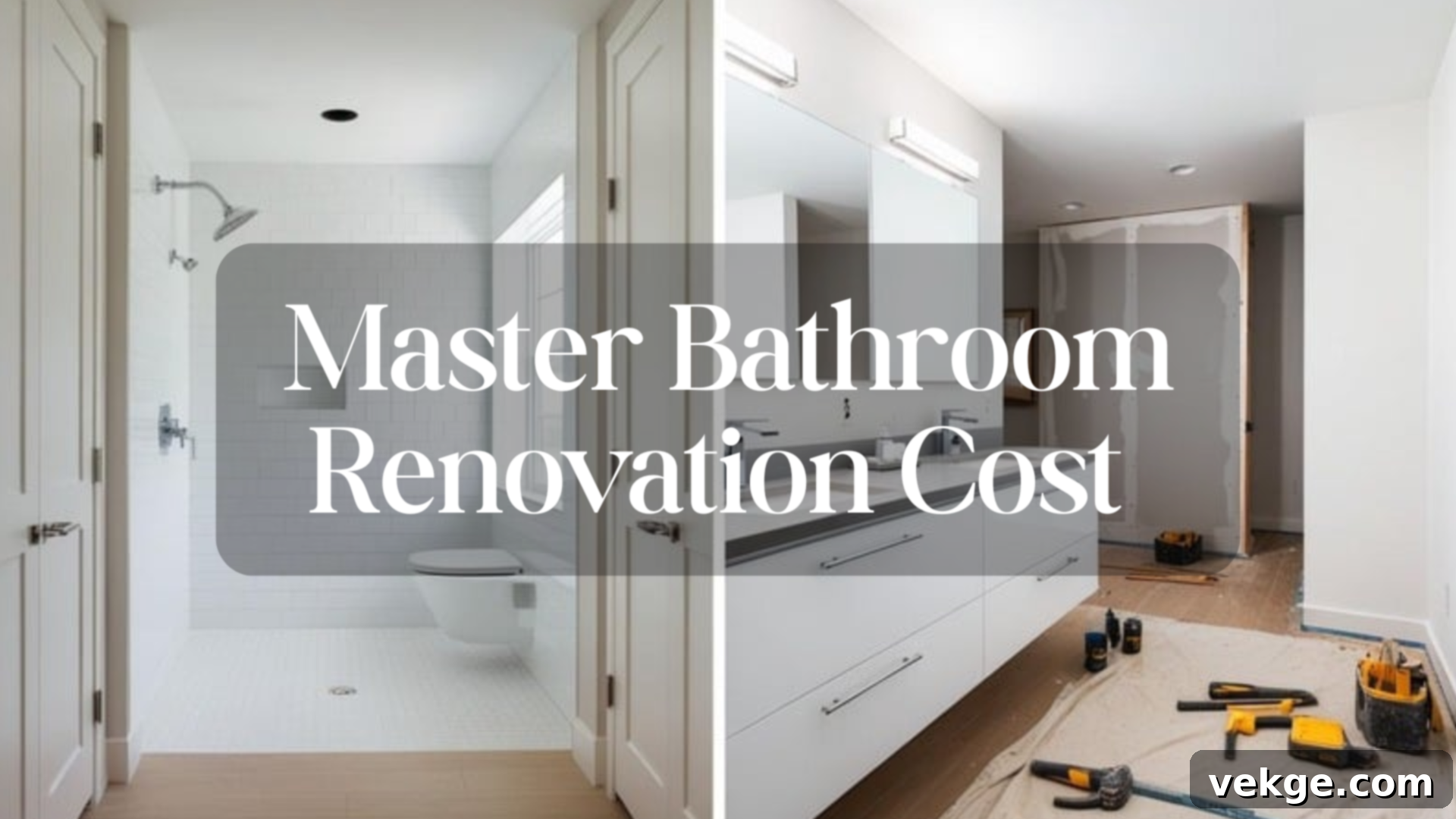Master Bathroom Renovation Costs: Your Ultimate 2025 Guide to Budgeting & Value
Dreaming of a refreshed master bathroom but unsure about the price tag? You’re certainly not alone. Many homeowners find themselves overwhelmed by the potential costs involved in transforming their private oasis. This comprehensive guide is designed to demystify master bathroom renovation expenses, providing you with transparent pricing insights to help you plan with confidence.
We’ve meticulously compiled the latest pricing data for 2025, covering everything from essential upgrades to luxurious overhauls. Whether your vision includes a simple refresh or a complete, high-end transformation, we’ll break down the expected costs for key elements such as showers, bathtubs, vanities, flooring, and more.
From a modest budget of $7,000 to an expansive project exceeding $75,000, this article offers practical, actionable information. Our goal is to equip you with the knowledge needed to budget effectively, avoid unforeseen expenses, and achieve the master bathroom you’ve always desired without any costly surprises.
Let’s dive into the detailed breakdown of what your dream master bathroom renovation might truly cost.
Average Cost of a Master Bathroom Renovation in 2025
Embarking on a master bathroom renovation requires careful financial foresight. Based on current market data from early 2025, the costs for updating a master bathroom can vary dramatically. These fluctuations are primarily driven by several key factors: the overall scope of your project, the quality of materials you select, and the specific labor rates in your local area.
The total cost for a master bathroom renovation typically ranges from a minimum of $7,000 for basic, cosmetic updates to well over $30,000 for more extensive and complete transformations. Your final expenditure will largely depend on the size of your bathroom, which specific items you choose to replace or upgrade, and the quality and brand of the materials and fixtures selected.
Typical Price Range for Master Bathroom Remodels
Master bathroom renovation costs generally fall into three distinct categories, reflecting different levels of project complexity and luxury:
- Basic Remodels: $7,000–$15,000
These entry-level projects focus on cosmetic enhancements and essential functionality without major structural changes. Expect simple updates like replacing old faucets and showerheads, a fresh coat of paint on walls, minor tile repairs or a basic regrout, and potentially a new toilet. At this budget, homeowners typically opt for standard, readily available materials from large home improvement retailers and strictly maintain the existing bathroom layout to minimize costs associated with plumbing or electrical modifications. - Mid-Range Projects: $20,000–$30,000
Stepping up to a mid-range budget allows for more significant improvements and higher-quality materials. This tier often includes replacing major fixtures such as the entire shower system, a new bathtub, a modern toilet, and a new vanity with an updated countertop. You might also upgrade to better quality flooring, like porcelain tile, and improve lighting. Small layout adjustments might be possible, but the renovation usually works within the existing footprint of the bathroom, avoiding costly reconfigurations of plumbing lines or wall removal. - High-End or Luxury Remodels: $40,000–$75,000+
At the premium end, luxury renovations offer comprehensive transformations and bespoke design elements. These projects can involve expanding the bathroom’s square footage, installing custom cabinetry, selecting high-quality natural stone countertops (like marble or quartz), and adding amenities such as heated floors, advanced custom shower systems with multiple sprayers, and top-grade designer fixtures. This level of renovation frequently includes moving walls, rerouting plumbing, and extensive electrical work, requiring skilled tradespeople and potentially an interior designer to achieve a truly customized and opulent space.
Average Master Bathroom Renovation Cost Across the USA
While the range is broad, most homeowners across the United States spend approximately $18,500 for a full master bathroom renovation. This national average typically represents a mid-range project that brings significant aesthetic and functional improvements without venturing into luxury territory.
For an $18,500 budget, you can expect to cover the costs for new, good quality fixtures, updated flooring throughout the space, a fresh paint job, and often the replacement of existing cabinets or the installation of a new vanity. The materials chosen at this price point usually strike an excellent balance between durability, contemporary style, and affordability, offering a noticeable upgrade from builder-grade or outdated elements.
Importantly, this average cost generally assumes that the existing bathroom layout remains largely intact, helping to keep labor and specialized plumbing costs in check. These figures are derived from current market data collected in early 2025, indicating that master bathroom renovation costs have shown relative stability compared to previous years, despite minor fluctuations in specific material prices.
Key Factors That Influence Your Master Bathroom Renovation Cost
Understanding the various elements that drive renovation expenses is crucial for effective budgeting and avoiding unexpected costs. Several factors significantly impact the final price of your master bathroom project.
1. Size of the Bathroom
The physical dimensions of your master bathroom are a primary cost driver. Larger bathrooms naturally demand more materials—more square footage of tile, a greater quantity of paint, additional flooring material, and often require more labor hours to complete the work. This direct relationship means that a spacious master bathroom will almost always cost more to renovate than a compact one.
For instance, renovating a small master bathroom (approximately 50 square feet) can cost significantly less than updating a much larger, 150-square-foot bathroom. The difference isn’t just in material volume; labor costs also scale up, as contractors and their teams need more time to prepare, install, and finish larger areas. When planning your budget, it’s essential to accurately measure your bathroom and calculate material needs based on precise square footage, rather than relying on rough estimates, to ensure a more realistic cost projection.
2. Materials and Fixtures Selection
Your choices regarding materials and fixtures have one of the most substantial impacts on your total renovation expenditure. The price spectrum for bathroom materials is exceptionally wide, catering to every budget and aesthetic preference.
- Flooring and Wall Tile: Tile prices can range dramatically, starting from as low as $1 per square foot for basic ceramic or vinyl options, to over $50 per square foot for premium materials like imported natural stone (marble, granite) or designer porcelain. Installation costs for tile also vary based on complexity, pattern, and the tile size.
- Countertops: Options range from affordable laminate (starting around $300 for a standard vanity size) to several thousand dollars for high-end materials such as custom-fabricated quartzite, marble, or granite. Engineered quartz also offers a durable and stylish mid-to-high range option.
- Fixtures: This category includes faucets, shower systems, and lighting. Basic, functional options from big-box stores might cost under $100 per fixture. In contrast, premium brands offering advanced features, unique finishes, or designer aesthetics can easily exceed $1,000 per fixture, especially for multi-function shower panels or high-end sconces.
- Cabinetry and Vanities: Pre-fabricated vanities are much more budget-friendly than custom-built cabinetry, which can run into thousands of dollars due to specialized design, materials, and labor.
Even seemingly minor selections like cabinet hardware, mirror frames, or towel bars can add up quickly if you consistently opt for premium or custom-made choices.
3. Layout Changes and Structural Work
Maintaining your bathroom’s existing layout is almost universally the most cost-effective approach. Any decision to alter the footprint or relocate key elements like toilets, showers, or sinks will significantly increase your renovation costs. Such changes necessitate:
- Additional Demolition: Removing existing structures and finishes to access plumbing and electrical lines.
- New Plumbing Lines: Rerouting water supply and drain lines, which can be complex and labor-intensive.
- Possible Electrical Rewiring: Moving outlets, switches, or light fixtures to accommodate the new layout.
- Structural Modifications: Especially for expanding shower spaces, moving load-bearing walls, or modifying floor joists for larger tubs or repositioned toilets.
Moving a toilet, for example, can be particularly expensive because its large 3-inch drain pipe often requires significant modifications to floor joists, which can be a structural challenge. Similarly, expanding a shower area or relocating a bathtub typically involves extensive plumbing work, waterproofing, and potentially pouring new concrete bases.
Each major layout change adds not only substantial labor hours but also considerable material costs to your project, potentially increasing your renovation expenses by $2,000 to $5,000 or even more, depending on the complexity.
4. Labor and Contractor Type
The professionals you hire for your master bathroom renovation will have a strong influence on your final price. Generally, there are two main types of contractors to consider, each with a different approach to pricing and project execution:
- Quality-Focused Contractors: These professionals prioritize exceptional craftsmanship, meticulous attention to detail, and often use higher-grade installation methods. They typically invest more time in ensuring every aspect of the renovation is perfect, from visible finishes to the unseen organization of plumbing and electrical work behind the walls. This approach usually results in higher labor costs but offers superior long-term durability, fewer issues down the line, and a more refined finished product.
- Budget-Focused Contractors: These contractors aim to minimize costs while still delivering acceptable results. They may work more quickly, suggest more affordable alternative materials, or employ simpler installation techniques to keep prices down. While this can be attractive for lower budgets, it’s crucial to ensure they are still licensed and insured and that their work meets local building codes.
Beyond contractor philosophy, regional labor rates play a significant role. The cost of living, demand for skilled trades, and local permit requirements can cause the same master bathroom renovation project to cost 20% to 30% more in one major metropolitan area compared to a smaller town or a different state. Always seek multiple quotes and verify contractor credentials, including licenses and insurance, to ensure a fair price and professional execution.
Cost Breakdown by Feature: What to Budget for Each Element
To effectively plan your master bathroom budget, it’s helpful to understand the typical costs associated with individual components. Below are detailed price ranges for common master bathroom features, based on current market rates in 2025, providing a clearer picture of where your money will go.
Bathtub and Shower Renovation Costs

The bathing area often represents the single largest portion of a master bathroom renovation budget, largely due to the materials, plumbing, and labor involved. A standard bathtub replacement typically costs between $659 and $2,100. This range depends heavily on the type of tub selected, from basic acrylic alcove models at the lower end to more luxurious freestanding or deep soaking tubs with jetted features, which command significantly higher prices.
Shower updates also vary widely in price and scope. Retiling an existing shower, which includes removing old tile, preparing the surface, installing new waterproofing membranes, and applying new tile, usually runs from $1,800 to $4,000. This cost can increase with more intricate tile designs, larger shower dimensions, or the addition of features like built-in niches, bench seats, or multiple shower heads (rain, handheld, body sprays).
A popular modernization trend is converting a traditional bathtub into a walk-in shower. This transformation costs between $1,800 and $4,400. This comprehensive project includes the demolition and removal of the old tub, necessary modifications to the plumbing, creation of a new shower base (often custom-tiled), installation of new wall surrounds (tile, acrylic, or solid surface panels), and the addition of shower doors. High-quality glass shower doors alone can add an extra $480 to $880 to your project, depending on whether you choose a frameless, semi-frameless, or framed design.
Vanity, Sink, and Cabinets Costs

Your bathroom vanity is a crucial element, serving both as a functional storage unit and a significant style focal point. New vanities range from $736 for basic, pre-made units readily available from retailers to $2,200 or more for custom-designed pieces featuring premium materials and bespoke finishes. Custom vanities offer tailored sizes, unique storage solutions, and a wider selection of wood types and finishes.
Sink and faucet combinations can vary from $460 for standard, functional options to $1,475 or higher for designer, higher-end designs. The type of sink chosen—whether an undermount (integrated into the countertop), a vessel sink (sitting on top), or an integrated sink (molded into the countertop material)—affects both aesthetic and price. Faucet styles, finishes (chrome, brushed nickel, matte black), and features (single-handle, widespread, touchless) also contribute to the overall cost.
Countertop costs for a typical master bathroom generally fall between $700 and $1,500. Laminate options are the most budget-friendly but may not offer the same durability or water resistance as solid surface materials. Natural stone (granite, marble) or engineered quartz typically fall into the mid-to-high range, offering superior aesthetics and longevity. The size of your vanity, the complexity of the cutouts for sinks, and any special edge treatments (e.g., bullnose, ogee) will also influence countertop pricing.
Flooring and Lighting Costs

Bathroom flooring creates the foundational style and comfort of your space. Installed costs typically range between $6 and $11 per square foot, covering both the material and professional labor. At the lower end of this spectrum, you’ll find options like sheet vinyl and basic ceramic tile, which are durable and water-resistant. Mid-range options include higher-quality porcelain tile and luxury vinyl plank (LVP), offering enhanced aesthetics and durability. Premium choices like natural stone (e.g., slate, limestone, marble) or wood-look porcelain planks command higher prices due to material cost and more complex installation requirements. Heated flooring systems can also be integrated for added comfort, significantly increasing the overall flooring budget.
Strategic lighting changes can dramatically transform your bathroom’s atmosphere and functionality. Basic light fixtures, such as simple ceiling lights or vanity bar lights, can start around $46, while premium, designer options, including decorative sconces, recessed lighting, or smart lighting systems, can easily reach $126 or more per fixture. For optimal results and functionality, consider incorporating multiple layers of lighting: ambient (general overhead lighting), task (vanity lighting for grooming), and accent lighting (to highlight architectural features or artwork).
A fresh coat of paint remains one of the most cost-effective and impactful updates you can make to your bathroom. A professional paint job for an average master bathroom typically costs between $56 and $103. This price generally includes thorough surface preparation, the application of moisture-resistant paint suitable for high-humidity environments, and careful, precise application around existing fixtures, trim, and ceilings. Choosing a new color can instantly refresh the entire space, making it feel cleaner and more modern without a hefty investment.
ROI and Long-Term Value of Your Master Bathroom Renovation
Investing in a master bathroom renovation goes beyond immediate aesthetic improvements; it impacts both your daily comfort and your home’s market value. Before committing to a major bathroom project, it’s wise to consider the financial and lifestyle benefits that extend beyond the newly improved space.
Is a Master Bathroom Renovation Worth It?
For the vast majority of homeowners, updating a master bathroom is a highly worthwhile investment. According to recent market data and homeowner surveys, there are three primary motivators driving people to renovate their master bathrooms:
- Improved Comfort and Functionality: Over 60% of homeowners undertake a renovation to create a more comfortable, user-friendly, and enjoyable space for daily routines. Outdated bathrooms frequently suffer from inefficient layouts, insufficient storage, worn-out fixtures, or poor lighting, making them frustrating and uninviting to use. A renovation directly addresses these pain points.
- Modernized Appearance: Bathroom styles evolve, and a dated master bathroom can make an entire home feel older and less appealing. New fixtures, contemporary materials, fresh color palettes, and updated design schemes contribute to a modern, cohesive look that enhances your personal enjoyment of the space and aligns with current design trends.
- Enhanced Functionality and Amenities: Many older master bathrooms were built without modern conveniences like spacious walk-in showers, ample counter space, dual sinks, or effective ventilation. Renovations that thoughtfully address these functional shortcomings can dramatically improve daily quality of life, turning a merely functional room into a true retreat.
The decision to renovate becomes particularly compelling if you plan to remain in your home for several years. You’ll reap the benefits of an upgraded space daily, and still recover a significant portion of your investment when you eventually decide to sell.
Return on Investment (ROI) for Master Bathroom Remodels
From a purely financial standpoint, master bathroom renovations typically offer solid returns compared to many other home improvement projects. Current data suggests that a mid-range master bathroom remodel can recoup approximately 58.9% of its cost when the home is sold. While this might not represent a full recovery of your outlay, it is a substantial partial return on your investment, making it a financially prudent upgrade.
For example, a $20,000 bathroom renovation could potentially add around $11,780 to your home’s selling price. It’s important to view this not just as a loss, but as an investment that enhances the home’s marketability and buyer appeal.
The ROI can be even more favorable under specific circumstances:
- Competitive Real Estate Markets: In areas where updated bathrooms are a standard expectation among buyers, a renovated master bathroom can be a decisive factor in attracting offers quickly and at a higher price.
- Significantly Outdated Homes: If your bathroom is notably antiquated compared to other homes in your neighborhood, an upgrade can dramatically improve its standing and perceived value.
- Replacing Problematic Features: Renovations addressing critical issues, such as leaking showers, damaged flooring, or non-functional fixtures, not only add value but also remove significant negotiating points for potential buyers.
Beyond the direct financial return, an updated master bathroom can significantly reduce the time your home spends on the market. Buyers are often willing to pay a premium for move-in ready homes, and outdated bathrooms are frequently cited as a major deterrent, sometimes leading to requests for substantial price reductions to cover anticipated renovation costs. An appealing master bathroom can be a strong selling point that differentiates your home.
Budgeting Tips for Your Master Bathroom Renovation
Achieving the master bathroom you desire without overspending is entirely possible with smart financial planning. Here’s how to create a realistic budget and effectively stick to it throughout your renovation journey.
How to Set a Smart Renovation Budget
Start your master bathroom renovation with a clear and detailed financial plan. First, prioritize your needs by separating your essential upgrades from your “wish list” items. Focus the majority of your spending on elements you interact with daily, such as the shower, vanity, and toilet, ensuring their quality and functionality, before allocating funds to specialty features or high-end aesthetics.
Utilize online cost calculators and local contractor estimates to gather custom projections based on your bathroom’s size and your renovation goals. These tools provide valuable baseline figures and help set realistic expectations for your project’s total cost before you even start shopping for materials.
Always include a contingency fund of 10% to 15% beyond your initial expected costs. This crucial buffer money is vital for covering unforeseen problems that frequently arise once walls are opened or old fixtures are removed, such as discovering water damage, outdated plumbing, mold, or electrical issues. Addressing these unexpected issues promptly prevents them from derailing your timeline and budget.
Make your material and scope choices in alignment with your home’s overall value. For homes valued under $300,000, for instance, aiming to keep master bathroom renovations under $40,000 helps ensure a good return on investment and prevents over-improving for your specific market.
Effective Ways to Save Money on Your Master Bathroom Remodel
While a renovation is an investment, there are several strategic ways to reduce costs without compromising too much on quality or aesthetic appeal:
- Maintain Existing Layout: Keeping your plumbing fixtures (toilet, shower, sinks) in their current locations can save thousands of dollars in labor and materials. Moving these elements requires extensive plumbing work, demolition, and potential permit changes, which quickly escalate costs.
- Choose Pre-Made Vanities: Opt for pre-fabricated vanities instead of custom cabinetry when possible. Many manufacturers offer a wide range of quality options with modern styles and finishes at a fraction of the cost of bespoke custom work.
- Mix High-End and Budget-Friendly Materials: Be strategic about where you splurge. Spend more on items you interact with daily or that make a significant visual impact (e.g., a quality faucet, durable flooring). Save money on less noticed areas or elements with readily available, affordable alternatives (e.g., a standard toilet, decorative accents, or less expensive subway tile for a shower surround).
- Get Multiple Contractor Quotes: Always obtain at least three detailed quotes from different reputable contractors before making a decision. This not only helps you find fair pricing but also allows you to identify any quotes that seem unusually low (potentially indicating cut corners) or excessively high. When comparing quotes, ensure that each proposal includes the same scope of work, similar quality materials, and transparent breakdown of labor and material costs.
- Consider DIY for Minor Tasks: If you have the skills and time, tackling simple tasks like painting, demolition of old fixtures, or even installing certain types of flooring can significantly reduce labor costs. However, always know your limits and leave complex plumbing, electrical, or tiling work to professionals.
- Purchase Materials During Sales: Keep an eye out for sales at home improvement stores, tile shops, and plumbing supply centers. Timing your purchases can lead to substantial savings on major components.
Conclusion
Planning a master bathroom renovation is a significant undertaking that requires careful consideration of both your personal needs and your financial budget. While the average homeowner spends around $18,500 on a complete master bathroom update, costs can fluctuate widely, ranging from $7,000 for basic refreshes to over $75,000 for high-end, luxury transformations. This variation largely depends on the project’s scope, material choices, and any layout changes.
To maximize your investment and minimize financial stress, remember to implement smart budgeting strategies. Keeping plumbing fixtures in their existing locations, strategically mixing high-end and budget-friendly materials, and obtaining multiple detailed contractor quotes are excellent ways to save money. Furthermore, always setting aside a contingency fund of 10-15% for unexpected issues is crucial to avoid costly surprises during the renovation process.
Ultimately, a well-planned and thoughtfully executed master bathroom update can profoundly improve your daily life by enhancing comfort and functionality. Beyond personal enjoyment, it also adds tangible value to your home, making it a worthwhile investment when approached with realistic expectations and intelligent planning. Your dream master bathroom is within reach with the right information and preparation.
